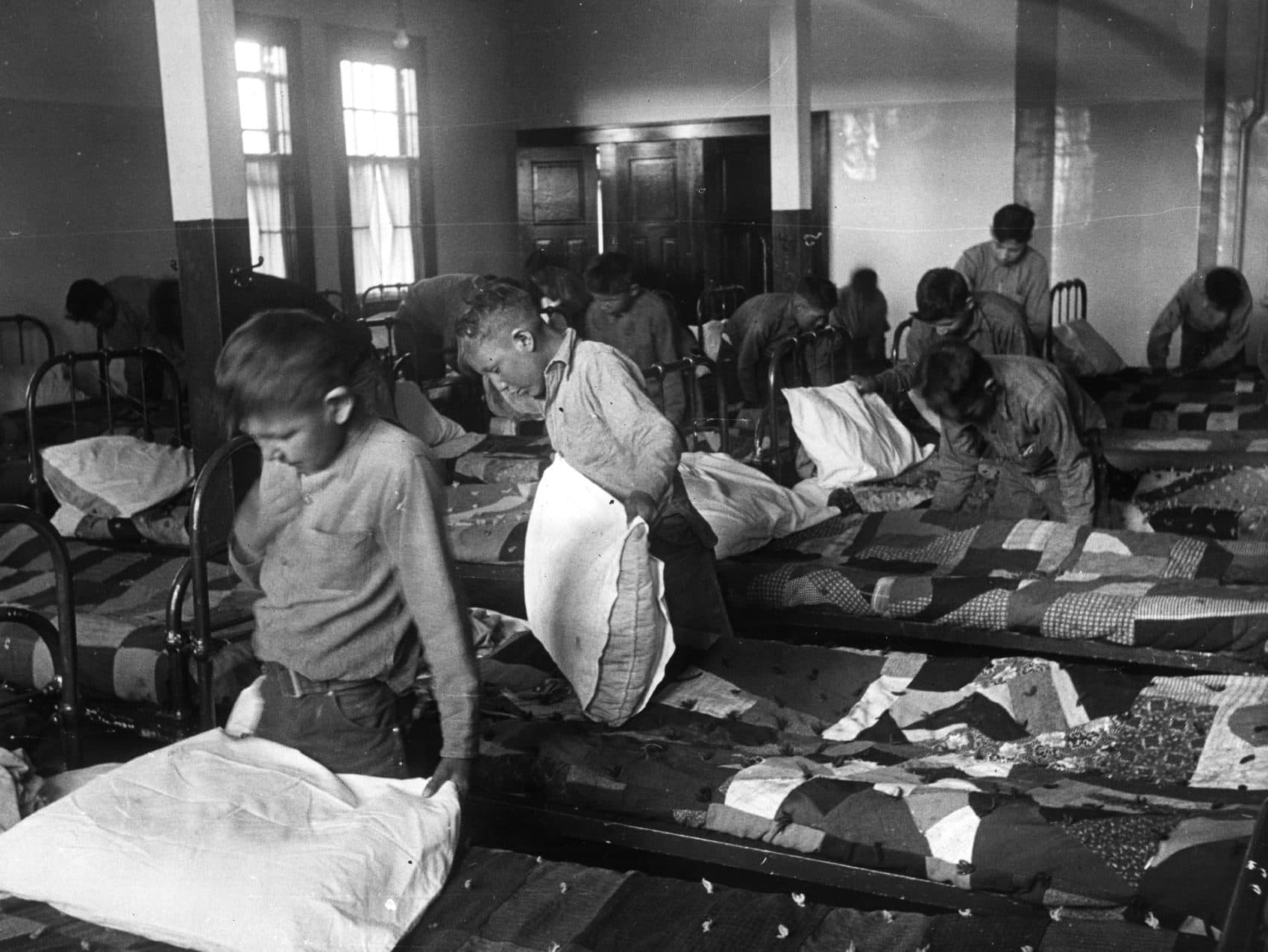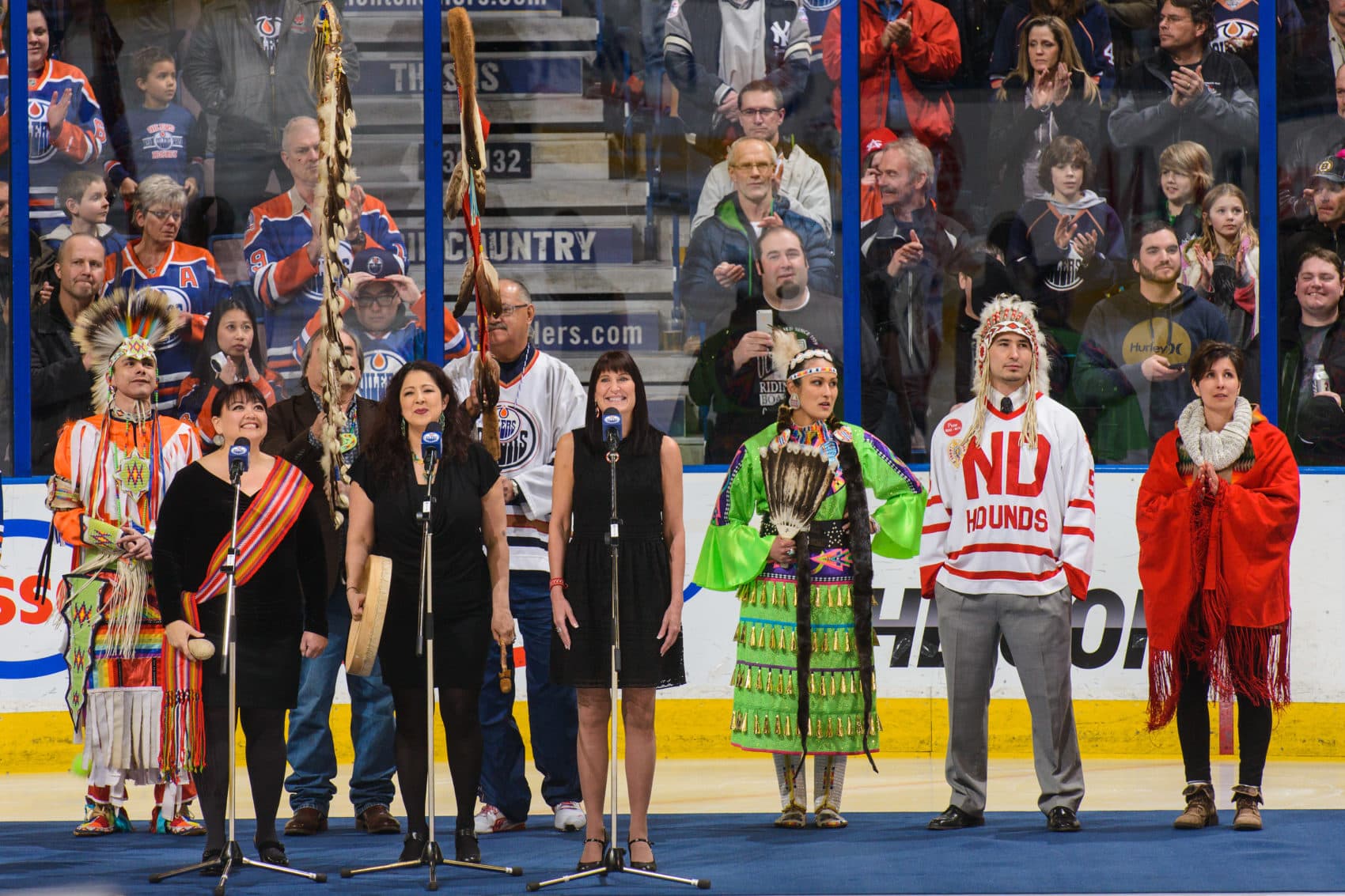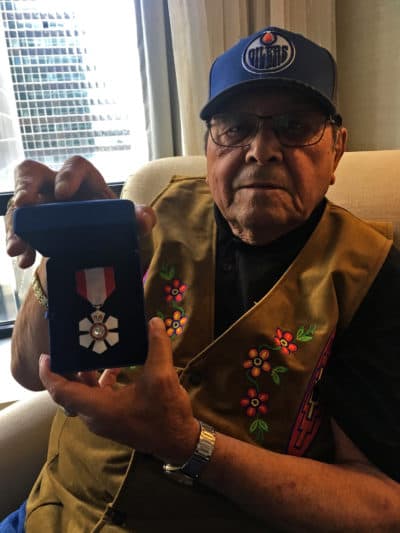Advertisement
The Story Of Fred Sasakamoose, An Indigenous Hockey Pioneer
In 1940, Indian agents with the Canadian government came to the Ahtahkakoop Cree reservation in central Saskatchewan. Six-year-old Fred Sasakamoose and his 8-year-old brother, Frank, were forcefully taken from their parents and thrown into a truck.
"We didn't know what the heck was going on," Fred says. "We didn’t know. We were too small."
Fred and about 30 other kids were driven five hours south to St. Michael’s Indian Residential School in Duck Lake, Saskatchewan.
"Just imagine when the kids were taken away from that reserve," Fred says. "The reservation was empty — just elders and parents. The kids were all gone."
Residential Schools
Between the 1880s and the 1990s, children were removed from Indigenous reserves all over Canada and put into residential schools as part of a national policy of assimilation.
"In order to understand what the residential schools were, you have to go back from Canada into the United States," says Clifton Ariwakehte Nicholas, a Mohawk activist from the Kanehsatake reserve near Montreal.
"The residential schools, as we know it in the modern context, originated in United States — what they called the ‘industrial schools,’ " Clifton says. "They wouldn't teach them anything academic, really. Beyond being able to operate whatever machines they would need."

Clifton never went to a residential school, but has many family members who did.
"In these schools, they would indoctrinate them into Christianity," Clifton says. " ‘Kill the Indian, save the child.’ "
Residential schools were administered by the Canadian government and local churches. At the schools, Indigenous kids were barred from speaking their languages. Thousands were tortured and even killed. Many Indigenous people have described what happened in the residential schools as genocide.
"It's almost genius — if it wasn't so evil," Clifton says. "How do you destroy a culture? How do you destroy a people and keep them down almost permanently? You kill their language. You kill their culture. You remove their maternal lines. There — you're done."
Sexual assault at the hands of priests, teachers and sometimes older kids was rampant in the schools. Fred himself is a survivor of such abuse.
Advertisement
"There was sex abuse in there — a lot of it," Fred says. "The priests and the sisters, well ... not going to talk about it."
Some children found cracks of light in the darkness. For Fred, that was hockey. The sport was introduced at St. Michael’s in 1944 by Father Georges Roussel, a French-Canadian priest who had just arrived from the hockey-crazed city of Montreal.
"He was just like a father, Father Roussel," Fred says. "You know, he cared. And he come to me and say, ‘Freddy, I'm going to make a champion out of you.’ "
Hockey At St. Michael's
Fred thought Father Roussel was a bit crazy. How could he make championship-winning hockey players out of the kids in the residential school? They had no freedom and were confined to the grounds.
But it turns out that Father Roussel was right.
"We won the provincial midget champion," Fred says. "Still got the sweater: St. Michael’s school. Won a little trophy: the best in Saskatchewan. We walked all over 'em."
“ ‘Freddy, I'm going to make a champion out of you.’ ”
Fred Sasakamoose
Hockey brought Fred joy. But he also remembers feeling sad.
"Loneliness," Fred says. "I wanted to go back to my parents. Somebody to hug me, to kiss me."
In 1948, at the age of 15, Fred aged out the residential school and went back to live with his parents on the reserve. He was happy to be reunited. But it wouldn’t last for long.
"Two months after, we were working in the field — working for a white man," Fred says. "I think it was three dollars a day. One afternoon, we were in the field there. I seen a car. Two people came out. When I recognized Father Roussel, I put my head down, and I said, ‘I ain't going back to school. I'm not going back. I'm home now.’ "
Fred says Father Roussel was with a big man in a long coat. His name was George Vogan. He wanted Fred to come with him — not to the residential school, but to Moose Jaw, Saskatchewan, to play junior hockey.
"I wanted to stay," Fred says. "Fame was nothing. Money was nothing. I want Mom and Dad. I look at dad, and he said, ‘You go, my son. Two weeks. In two weeks you come back.’
"I went with George. We traveled for ... oh man, eight hours? Long ways. We got to this place, a little town called Moose Jaw. He said, ‘That's where I live.’ He took me home."
The Moose Jaw Canucks
Vogan had brought Fred to Moose Jaw to try out for the Canucks, a junior hockey team. But Fred struggled to fit in.
"A hundred thirty kids at training camp," Fred says. "A hundred thirty. All white. I was shamed — shamed at being Indian. I could never change it."
Fred says George and his wife took good care of him. But his heart yearned for home.
"Sometimes I cry. You kinda have to excuse me a little bit," Fred says. "I looked back to the North, where I come from. It was just like a curtain. Black. Everything goes dark. It's like there was nothing there. My life. I left everything behind."
As the days went by, Fred’s homesickness got worse.
"I was starting to talk to these white kids," Fred remembers. "Where’s that little — my friend that was sitting beside me? ‘Oh, he got sent home,’ he said. ‘Not good enough.’ I said, ‘I'm the one who want to go home.’ I said, ‘Why didn't they send me home?’ "
Fred had only been in Moose Jaw for two weeks. But it was enough. So, at 8 am, just after George and his wife had left for work, Fred packed up a bag and snuck away.
"North," Fred says. "I knew the direction to go. I start walking. I went 28 miles. A car pulled up — and here's George. He said, ‘Where you going, Freddie?’ I said, ‘Two weeks, George. Going home.’
“It didn't matter about money, glory ... It didn’t matter. I didn't want that. I wanted home.”
Fred Sasakamoose
"He looked down, and he had tears coming down his eyes. He begged. He begged. ‘You come back. I'll give you 50 cents a day.’ Was a lot of money, 50 cents at that time. You could buy a pop and two ice creams. ‘Another two weeks — and if you don't make it, I'll drive you home. But just give me two more weeks,’ he said."
Fred agreed to return to Moose Jaw and the Canucks training camp.
"I see kids that were leaving, Fred says. "They were down to 50. Down to 35 ... And I was still there. And I was skating hard. George would lace up my shoes — my skates. He would sit there and just lace them, you know. He wouldn’t leave me alone.
"I made it. I made that team."
So Fred stayed in Moose Jaw.
"George Vogan — a white man, who helped me," Fred says. "Every day, he would hug me, walk me down the street. And he'd hold my hand. ‘You see that rainbow? We’ll walk that rainbow together. At the end of that rainbow is pot of gold. You know what that pot of gold is?’ And he'd point. ‘It's you.’ "
An Announcement
In 1953, at the end of Fred’s fourth and final season of junior hockey eligibility, Fred and the Moose Jaw Canucks lost to the Regina Pats in the playoffs. After the game, Fred’s team headed into the dressing room. It was there that Fred would get some news that would change his life.
"George walked in," Fred says. "He said, ‘Don't take your stuff off. There's an announcement to be made.’ "
George had a telegram in his hand.
"All these 24 kids had a vision," Fred says. "They wanted to go to the National League. NHL. When he opened that paper: ‘Fred Sasakamoose — report immediately to Chicago Blackhawks.’ Wow. The room just went still."
Fred, now 20 years old, would be a pro. So he left Moose Jaw, going even further away from home.
"I went to the Chicago," Fred says. "Wow. I look in that dressing room of the Chicago Blackhawk. I see number 21. On top of that number 21: ‘Sasakamoose’. That's what it was all about."
On Nov. 20, 1953, Fred played his first game with the Blackhawks.
"You step on that ice," Fred says. "You could hear drums, just like that. Big Chicago stadium — three balconies, like that."
“ ‘Fred Sasakamoose — report immediately to Chicago Blackhawks.’ Wow. The room just went still.”
Fred Sasakamoose
But Fred only played 11 games for the Blackhawks. He left at the end of the season.
"I wanted to go home all the time," Fred says. "You're no longer 500 miles away — you are 5,000 miles away. It didn't matter about money, glory ... It didn’t matter. I didn't want that. I wanted home."
11 games. Not one goal — not even an assist. But with those 11 games, Fred made his mark on hockey history by being the one of the first Indigenous people to play in the NHL.

Canadian Recognition
Fred was a trailblazer. His legacy lives on today among thousands of First Nations hockey fans who saw the Fred Sasakamoose story as an inspiration.
"I think Fred was definitely the bridge builder," sayd Irkar Beljaars, an Indigenous writer, radio broadcaster and life-long hockey fan living in Montreal. "Just through his actions gave opportunities.
"Fred is like an icon in our communities. Because our youth — who are dealing with so many issues, like suicide and alcoholism and drug abuse, and just coming from really, really dark places themselves — and they see this guy become a professional hockey player. It’s something that's very important for our youth, and I really hope that we see more of that."
Of the roughly 700 players in the NHL today, fewer than 10 are of Indigenous descent. While it’s a small group, there are some all-stars among them, including world-class goaltender Carey Price and TJ Oshie of the Stanley Cup–winning Washington Capitals.

In 2008, under then–Prime Minister Stephen Harper, the Canadian government issued an official apology for its residential school policy. The gesture was controversial. Many Indigenous people saw the apology as empty words while their rights were still being violated.
I was there with Fred as he traveled to Ottawa to receive the Order of Canada last spring, for his decades of work lifting up Indigenous youth through hockey programs back home in Ahtahkakoop. And I could see the pride in his eyes as he was handed the medal. I asked him him how it felt in his own words.
"Oh boy," Fred says. "That was one of the greatest moments, I think, in life. It's great."
Fred is 84 now. He lives back home in Ahtahkakoop, Saskatchewan, surrounded by his wife, their kids and 128 grandkids and great grandkids. He still loves to settle down in front of the TV to watch hockey games. And he’s a lifelong fan of the Blackhawks.
This article was originally published on September 14, 2018.
This segment aired on September 15, 2018.